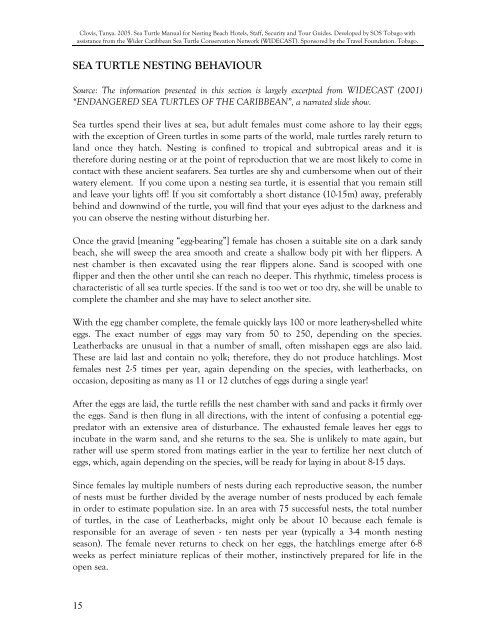Clovis, Tanya. - WIDECAST
Clovis, Tanya. - WIDECAST
Clovis, Tanya. - WIDECAST
Create successful ePaper yourself
Turn your PDF publications into a flip-book with our unique Google optimized e-Paper software.
<strong>Clovis</strong>, <strong>Tanya</strong>. 2005. Sea Turtle Manual for Nesting Beach Hotels, Staff, Security and Tour Guides. Developed by SOS Tobago with<br />
assistance from the Wider Caribbean Sea Turtle Conservation Network (<strong>WIDECAST</strong>). Sponsored by the Travel Foundation. Tobago.<br />
SEA TURTLE NESTING BEHAVIOUR<br />
Source: The information presented in this section is largely excerpted from <strong>WIDECAST</strong> (2001)<br />
“ENDANGERED SEA TURTLES OF THE CARIBBEAN”, a narrated slide show.<br />
Sea turtles spend their lives at sea, but adult females must come ashore to lay their eggs;<br />
with the exception of Green turtles in some parts of the world, male turtles rarely return to<br />
land once they hatch. Nesting is confined to tropical and subtropical areas and it is<br />
therefore during nesting or at the point of reproduction that we are most likely to come in<br />
contact with these ancient seafarers. Sea turtles are shy and cumbersome when out of their<br />
watery element. If you come upon a nesting sea turtle, it is essential that you remain still<br />
and leave your lights off! If you sit comfortably a short distance (10-15m) away, preferably<br />
behind and downwind of the turtle, you will find that your eyes adjust to the darkness and<br />
you can observe the nesting without disturbing her.<br />
Once the gravid [meaning “egg-bearing”] female has chosen a suitable site on a dark sandy<br />
beach, she will sweep the area smooth and create a shallow body pit with her flippers. A<br />
nest chamber is then excavated using the rear flippers alone. Sand is scooped with one<br />
flipper and then the other until she can reach no deeper. This rhythmic, timeless process is<br />
characteristic of all sea turtle species. If the sand is too wet or too dry, she will be unable to<br />
complete the chamber and she may have to select another site.<br />
With the egg chamber complete, the female quickly lays 100 or more leathery-shelled white<br />
eggs. The exact number of eggs may vary from 50 to 250, depending on the species.<br />
Leatherbacks are unusual in that a number of small, often misshapen eggs are also laid.<br />
These are laid last and contain no yolk; therefore, they do not produce hatchlings. Most<br />
females nest 2-5 times per year, again depending on the species, with leatherbacks, on<br />
occasion, depositing as many as 11 or 12 clutches of eggs during a single year!<br />
After the eggs are laid, the turtle refills the nest chamber with sand and packs it firmly over<br />
the eggs. Sand is then flung in all directions, with the intent of confusing a potential eggpredator<br />
with an extensive area of disturbance. The exhausted female leaves her eggs to<br />
incubate in the warm sand, and she returns to the sea. She is unlikely to mate again, but<br />
rather will use sperm stored from matings earlier in the year to fertilize her next clutch of<br />
eggs, which, again depending on the species, will be ready for laying in about 8-15 days.<br />
Since females lay multiple numbers of nests during each reproductive season, the number<br />
of nests must be further divided by the average number of nests produced by each female<br />
in order to estimate population size. In an area with 75 successful nests, the total number<br />
of turtles, in the case of Leatherbacks, might only be about 10 because each female is<br />
responsible for an average of seven - ten nests per year (typically a 3-4 month nesting<br />
season). The female never returns to check on her eggs, the hatchlings emerge after 6-8<br />
weeks as perfect miniature replicas of their mother, instinctively prepared for life in the<br />
open sea.<br />
15
















